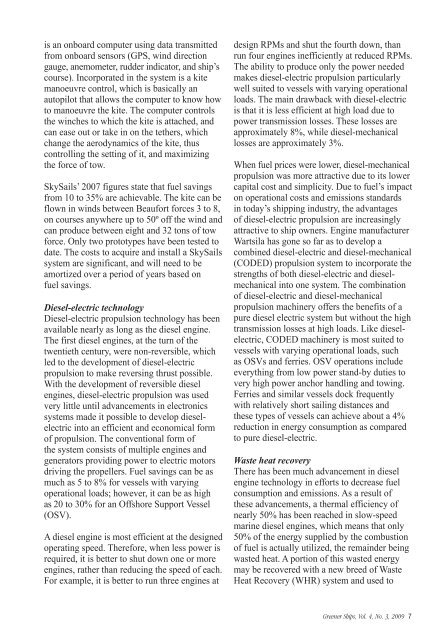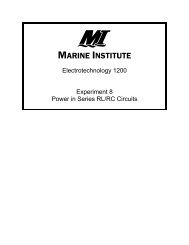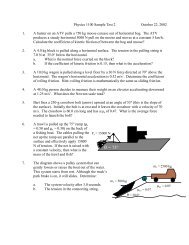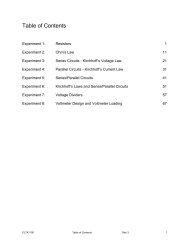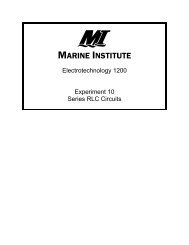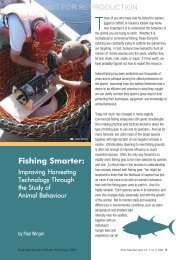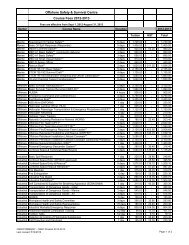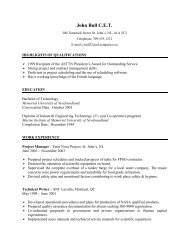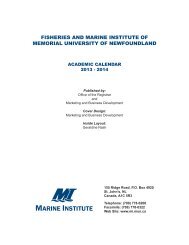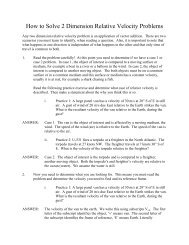Hybrid Marine Propulsion on the Tugboat Carolyn Dorothy
Hybrid Marine Propulsion on the Tugboat Carolyn Dorothy
Hybrid Marine Propulsion on the Tugboat Carolyn Dorothy
You also want an ePaper? Increase the reach of your titles
YUMPU automatically turns print PDFs into web optimized ePapers that Google loves.
is an <strong>on</strong>board computer using data transmitted<br />
from <strong>on</strong>board sensors (GPS, wind directi<strong>on</strong><br />
gauge, anemometer, rudder indicator, and ship’s<br />
course). Incorporated in <strong>the</strong> system is a kite<br />
manoeuvre c<strong>on</strong>trol, which is basically an<br />
autopilot that allows <strong>the</strong> computer to know how<br />
to manoeuvre <strong>the</strong> kite. The computer c<strong>on</strong>trols<br />
<strong>the</strong> winches to which <strong>the</strong> kite is attached, and<br />
can ease out or take in <strong>on</strong> <strong>the</strong> te<strong>the</strong>rs, which<br />
change <strong>the</strong> aerodynamics of <strong>the</strong> kite, thus<br />
c<strong>on</strong>trolling <strong>the</strong> setting of it, and maximizing<br />
<strong>the</strong> force of tow.<br />
SkySails’ 2007 figures state that fuel savings<br />
from 10 to 35% are achievable. The kite can be<br />
flown in winds between Beaufort forces 3 to 8,<br />
<strong>on</strong> courses anywhere up to 50º off <strong>the</strong> wind and<br />
can produce between eight and 32 t<strong>on</strong>s of tow<br />
force. Only two prototypes have been tested to<br />
date. The costs to acquire and install a SkySails<br />
system are significant, and will need to be<br />
amortized over a period of years based <strong>on</strong><br />
fuel savings.<br />
Diesel-electric technology<br />
Diesel-electric propulsi<strong>on</strong> technology has been<br />
available nearly as l<strong>on</strong>g as <strong>the</strong> diesel engine.<br />
The first diesel engines, at <strong>the</strong> turn of <strong>the</strong><br />
twentieth century, were n<strong>on</strong>-reversible, which<br />
led to <strong>the</strong> development of diesel-electric<br />
propulsi<strong>on</strong> to make reversing thrust possible.<br />
With <strong>the</strong> development of reversible diesel<br />
engines, diesel-electric propulsi<strong>on</strong> was used<br />
very little until advancements in electr<strong>on</strong>ics<br />
systems made it possible to develop dieselelectric<br />
into an efficient and ec<strong>on</strong>omical form<br />
of propulsi<strong>on</strong>. The c<strong>on</strong>venti<strong>on</strong>al form of<br />
<strong>the</strong> system c<strong>on</strong>sists of multiple engines and<br />
generators providing power to electric motors<br />
driving <strong>the</strong> propellers. Fuel savings can be as<br />
much as 5 to 8% for vessels with varying<br />
operati<strong>on</strong>al loads; however, it can be as high<br />
as 20 to 30% for an Offshore Support Vessel<br />
(OSV).<br />
A diesel engine is most efficient at <strong>the</strong> designed<br />
operating speed. Therefore, when less power is<br />
required, it is better to shut down <strong>on</strong>e or more<br />
engines, ra<strong>the</strong>r than reducing <strong>the</strong> speed of each.<br />
For example, it is better to run three engines at<br />
design RPMs and shut <strong>the</strong> fourth down, than<br />
run four engines inefficiently at reduced RPMs.<br />
The ability to produce <strong>on</strong>ly <strong>the</strong> power needed<br />
makes diesel-electric propulsi<strong>on</strong> particularly<br />
well suited to vessels with varying operati<strong>on</strong>al<br />
loads. The main drawback with diesel-electric<br />
is that it is less efficient at high load due to<br />
power transmissi<strong>on</strong> losses. These losses are<br />
approximately 8%, while diesel-mechanical<br />
losses are approximately 3%.<br />
When fuel prices were lower, diesel-mechanical<br />
propulsi<strong>on</strong> was more attractive due to its lower<br />
capital cost and simplicity. Due to fuel’s impact<br />
<strong>on</strong> operati<strong>on</strong>al costs and emissi<strong>on</strong>s standards<br />
in today’s shipping industry, <strong>the</strong> advantages<br />
of diesel-electric propulsi<strong>on</strong> are increasingly<br />
attractive to ship owners. Engine manufacturer<br />
Wartsila has g<strong>on</strong>e so far as to develop a<br />
combined diesel-electric and diesel-mechanical<br />
(CODED) propulsi<strong>on</strong> system to incorporate <strong>the</strong><br />
strengths of both diesel-electric and dieselmechanical<br />
into <strong>on</strong>e system. The combinati<strong>on</strong><br />
of diesel-electric and diesel-mechanical<br />
propulsi<strong>on</strong> machinery offers <strong>the</strong> benefits of a<br />
pure diesel electric system but without <strong>the</strong> high<br />
transmissi<strong>on</strong> losses at high loads. Like dieselelectric,<br />
CODED machinery is most suited to<br />
vessels with varying operati<strong>on</strong>al loads, such<br />
as OSVs and ferries. OSV operati<strong>on</strong>s include<br />
everything from low power stand-by duties to<br />
very high power anchor handling and towing.<br />
Ferries and similar vessels dock frequently<br />
with relatively short sailing distances and<br />
<strong>the</strong>se types of vessels can achieve about a 4%<br />
reducti<strong>on</strong> in energy c<strong>on</strong>sumpti<strong>on</strong> as compared<br />
to pure diesel-electric.<br />
Waste heat recovery<br />
There has been much advancement in diesel<br />
engine technology in efforts to decrease fuel<br />
c<strong>on</strong>sumpti<strong>on</strong> and emissi<strong>on</strong>s. As a result of<br />
<strong>the</strong>se advancements, a <strong>the</strong>rmal efficiency of<br />
nearly 50% has been reached in slow-speed<br />
marine diesel engines, which means that <strong>on</strong>ly<br />
50% of <strong>the</strong> energy supplied by <strong>the</strong> combusti<strong>on</strong><br />
of fuel is actually utilized, <strong>the</strong> remainder being<br />
wasted heat. A porti<strong>on</strong> of this wasted energy<br />
may be recovered with a new breed of Waste<br />
Heat Recovery (WHR) system and used to<br />
Greener Ships, Vol. 4, No. 3, 2009 7


